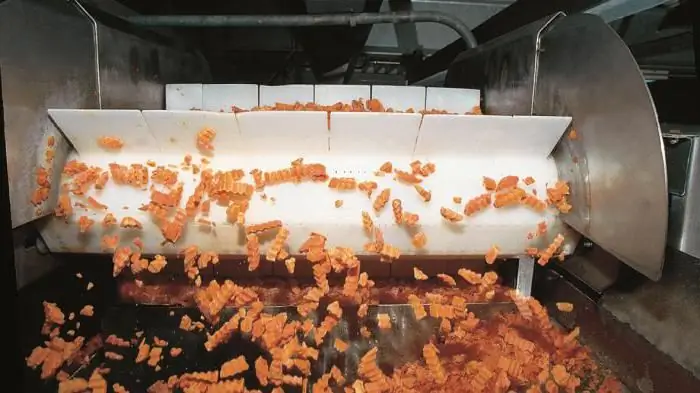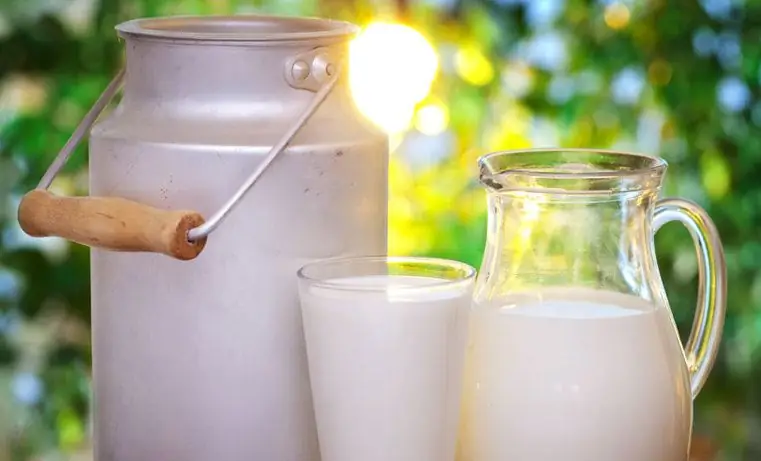2025 Author: Howard Calhoun | [email protected]. Last modified: 2025-01-24 13:10:43
Milk, as you know, is a perishable product. It must be stored and transported properly. Otherwise, a product that is not very tasty, and possibly even unsafe for he alth, will reach the consumer.
Primary processing steps
Milk spoils primarily due to the fact that it is an ideal environment for the development of microorganisms. Therefore, immediately after milking, it must be subjected to:
- cleaning up;
- cooling.
Dairy processing plants also carry out:
- quality control and accounting;
- product acceptance.

In some cases, the primary processing of milk on farms or factories may include procedures such as pasteurization and sterilization. This product is transported from farms to processing sites in tanks or flasks, which, of course, must be kept clean.
Technologically, the primary processing of milk can be quite complicated. When performed infarms use a variety of, often expensive, equipment. In any case, on each farm for the primary processing of the produced product, special facilities are required.
In large farms, this procedure can be performed even in detached buildings specially built for this purpose. In such buildings, among other things, even entire lines for the primary processing of milk are often installed.
Cleaning Methods
In milk, even with the most careful observance of sanitary and hygienic milking standards, there are always, among other things, various mechanical impurities and suspensions. On farms, depending on the type of equipment used, two methods of milk purification can be used. Both of them allow you to remove mechanical impurities quite effectively.
If a manual portable machine is used for milking on the farm, cleaning is usually done when milk is poured into flasks. A mesh metal grate is pre-installed on the neck of such containers. Next, gauze folded several times is laid on it. Then the milk is actually poured into the flask.

Sometimes, instead of gauze, special factory filters can be used on farms to clean the milk product. Such devices are also simply placed on the neck of the containers before pouring milk into them. One such filter is usually designed to fill 2-3 flasks. Further, such devices are thoroughly washed in a warm solution.detergent. Depending on the type of material used for the manufacture, the filter must be disposed of after 10-180 days.
When using automated milking lines, cleaning of the product on farms is usually done using a different technology. In this case, a filter cloth cover is simply put on the expanded end of the milk line.
The most efficient cleaning method
On large farms, milk can also be passed through a special centrifugal separator to remove mechanical impurities. The product itself is first poured into such an apparatus. Next, the separator is connected to the network. Thanks to the rotation of the drum of this device, even the smallest particles, as well as bacteria in the processed product, are nailed to the walls. It is believed that the mechanization of the primary processing of milk at this stage and the use of such a technique makes it possible to remove up to 99.9% of microorganisms from milk.
Sanitary requirements
It is believed that the best way to remove impurities from milk is when it is processed almost immediately after milking. That is, when the temperature of this product during filtration or centrifugal cleaning is 30-35 degrees. But in any case, according to sanitary rules, milk must be processed to remove mechanical impurities no later than 2 hours after milking at a temperature not lower than 25 °C.
Why you need refrigeration
The acidity of milk under normal conditions can rise very quickly. And in order for this product to retain its properties until the moment of sale or processing, cooling is necessary. ToFor example, at a temperature of 12 ° C, milk does not begin to turn sour for 10 hours. That is, the total number of microorganisms in this period does not increase in it. At a temperature of 2-4 ° C, the development of lactic acid bacteria stops altogether.
Cooling guidelines
This procedure, which is the most important stage in the primary processing of milk, is considered one of the most energy-intensive on farms. The cost of electricity for cooling 1 ton of milk can reach 40-50 kW/h. After cleaning, according to the standards, such a product should be cooled in summer to +2 … +4 ° С, in winter - to +6 ° С. This avoids spoilage for a long time. In any case, milk on the farm must be cooled to +4…+7 °C maximum 4 hours after milking.

Milk primary processing technology: cooling
This procedure can be done on farms using several techniques:
- In running or ice water in flasks.
- In cooling tanks.
- In special plate or irrigation installations.
It is believed that the most rational cooling technology for the primary processing of milk on farms is a two-stage one. This technique can significantly reduce energy costs on farms. When using this technology, the milk is cooled:
- up to 17°C in the milking flow;
- up to 7-8°C on tubular or plate brine cooler.
Sometimes on farms in premises for primaryprocessing, direct cooling tanks are also used, in which you can collect the product from several milkings and send it for sale within 2 days. Additionally, such equipment is used for heating water due to heat exchange. That is, the mechanization of the primary processing of milk at this stage allows you to save both on electricity and on transportation.
What sanitary rules should be observed during transportation
Purified and cooled milk from farms can be transported in tanks or in flasks. At the same time, when transporting this perishable product, of course, certain requirements must be observed:
- The machine used to transport milk must have a passport issued by the territorial body of the State Sanitary and Epidemiological Supervision. It is necessary to confirm such a document every 6 months. It is forbidden to let vehicles into the territory of the dairy without a passport.
- It is also impossible to transport milk along with meat, fish, poultry, eggs and some other products. In addition, this product must not be transported in vehicles that have previously transported pesticides, gasoline, kerosene, or any strong-smelling substances.
- The chauffeur-forwarding agent must have a personal medical book with marks on examinations. Transportation of milk is allowed only in overalls.
- Milk from cows suffering from mastitis, leukemia, brucellosis, etc. must be transported in a separate container.
- During the summer, the temperature of the milk must rise during transportationno more than 1-2 g per 100 km.
According to the regulations, in summer, the total time for loading / unloading and transporting milk in flasks that has passed the primary processing procedure in special refrigerators should not exceed 6 hours, and in ordinary on-board vehicles - 2 hours.
Transportation in tanks
This method of transporting milk to enterprises is often used by large farms. The filling of tanks in farms is carried out under vacuum created by a pump or a car engine. Each section of such a container must be hermetically sealed. The product is fed into the tanks through milk pipelines into the tank from below. This avoids foaming.
Drainage of milk at the plant is carried out by gravity or under the action of a special pump. Inspection of tanks and their washing are carried out through special hatches.
Factory Acceptance
At the factory, milk from the farm is delivered to the receiving workshop, which must be equipped with the following equipment:
- counters;
- scales;
- pumps;
- tanks;
- wash equipment;
- platforms for tanks, etc.
A preliminary check of milk brought from the farm should be carried out by an inspector with the appropriate qualifications, or a master with the obligatory participation of a laboratory assistant. Upon arrival of the tanks, these specialists first of all inspect the container for its cleanliness. Contaminated flasks before draining milk from them, according to the regulations, must bewashed well.
After opening the container, the persons responsible for acceptance carry out, among other things, the following procedures:
- determine the smell of milk and its temperature;
- take a sample to assess the quality in the laboratory.
In the future, milk is subjected to the most thorough laboratory tests for the presence of pathogenic bacteria, all sorts of harmful impurities, etc. This product, of course, must be supplied uncontaminated and absolutely pure for sale. Unfortunately, very serious, dangerous diseases can also be transmitted through milk to humans.
Sterilization
This procedure is used on farms and sometimes in processing plants to kill both spore and vegetative bacteria. For sterilization, milk during primary processing at the farm or factory is heated above the boiling point. There are several methods for such processing:
- at a temperature of +103…+108 °С in autoclaves and bottles for 14-18 minutes;
- at a temperature of +117…+120 °С in continuous sterilizing bottles for 15-20 minutes;
- at a temperature of +140…+142 °C instantly, followed by bottling into airtight paper bags.
The milk sterilization procedure allows you to store it in an airtight container even at room temperature for a very long time. But at the same time, the quality of the product after performing this operation, unfortunately, deteriorates. So, for example, in the process of sterilization in milkup to 50% of vitamins C and B are destroyed 12. In addition, the rennet clotting of this product is deteriorating.

Pasteurization
This procedure often also becomes one of the stages in the primary processing of milk on farms. When it is performed, the product can heat up to a temperature of +63…+90 °C. The main purpose of pasteurization, as well as sterilization, is the destruction of pathogenic microflora. The milk that has undergone such a procedure is stored later on for much longer. It is believed that up to 99.9% of pathogenic bacteria can be destroyed by pasteurization. That is, the product eventually becomes practically sterile.
Like sterilization, this procedure can be carried out both directly on farms and in factories. It is pasteurization that is the main method of neutralizing pathogenic microflora in milk supplied to shops, canteens, etc.
There are three main modes of such processing on farms and factories:
- at 63-65°C for 30 minutes;
- at 72-76°C for 15-20 minutes;
- instantly at 85-87°C.
Equipment for primary milk processing at this stage can be used, for example:
- universal tank;
- bath for long-term pasteurization;
- tube pasteurizers, etc.
When using all three modes, the properties of milk may change slightly. So, after the"gentle" pasteurization in the product begins to denature albumin. At temperatures above 85 ° C, calcium is split off from casein in the product. Under the same conditions, milk, among other things, acquires a specific aroma and taste, well known to many consumers.

As with sterilization, pasteurization destroys vitamins C and B in the product. Also, after heating, less enzymes remain in the milk. Soluble phosphate s alts are converted into insoluble ones in it.
Storage: sanitary standards
After primary processing, milk may remain on the farm for some time before being sent to the factories. To store this product on the farm so that its properties do not change, it is necessary, of course, correctly. Otherwise, this product may simply not be accepted at the processing plant. For storage of milk on farms can be used:
- tanks;
- tanks;
- baths;
- flasks.
Cooling is an important step in such a procedure as the primary processing of milk. And the storage of this product should be carried out subsequently, of course, at low temperatures.

Of course, on farms, among other things, the terms of exposure of this product before being sent to the enterprise are observed. According to the regulations, at a temperature of +8 ° C, the maximum shelf life of milk should not exceed 12 hours; 6-8 °C - 12-18 hours; 4-6 °С -18-24h
What sanitary requirements should be observed on the farm
The product sent from the farms must therefore be fresh and clean. Milking and primary processing of milk must be carried out in conditions that meet all sanitary standards. Also, milk intended for sale must be whole and obtained from he althy cows. To ensure that this product does not become contaminated with any microorganisms or absorb foreign odors, the following requirements must be observed during milking, primary processing and storage on the farm:
- periodic cleaning of milking equipment;
- compliance with industrial and personal hygiene by farm workers.
Also, the strictest veterinary control should be carried out on the farm. Diseases of cows on the farm should be detected in time.

In addition, in no case should the milking machines be allowed to fall and suck manure and bedding into them. Of course, all primary milk processing machines should also be kept clean.
Recommended:
Mine well: device, sanitary requirements, value

Description of the construction of shaft wells. What are the requirements for structures during construction and operation. Features of concrete, plastic, wood and brick products. Necessary conditions for the start of construction or restoration. Sanitary standards for the operation of mine wells
Processing primary documentation: requirements, example. Primary accounting documentation

The activity of any enterprise is closely connected with the maintenance and processing of primary documentation. It is necessary for reporting, calculating tax payments, making management decisions
Primary accounting documents: types, processing and storage

Carrying out accounting at enterprises of various forms of ownership is impossible without documentary reflection. Not a single procedure, not a single project, not a single business transaction is carried out without a correctly executed document, regulated by the internal orders of the enterprise and external legislative norms. Each action performed by an employee is reflected in the documentary base, which is based on a list of primary documents
Meat: processing. Equipment for meat and poultry processing. Production, storage and processing of meat

Information of state statistics show that the volume of meat, milk and poultry consumed by the population has significantly decreased in recent years. This is caused not only by the pricing policy of manufacturers, but also by the banal shortage of these products, the required volumes of which simply do not have time to produce. But meat, the processing of which is an extremely profitable business, is very important for human he alth
Primary meat processing: consistency, technology

Primary processing of meat is a whole range of technological operations that are performed in any production. For different raw materials, in most cases, the same equipment is used

